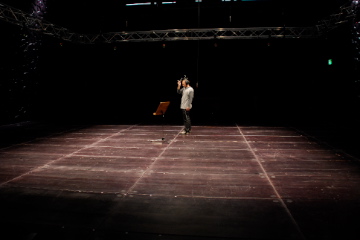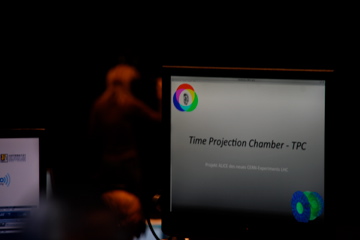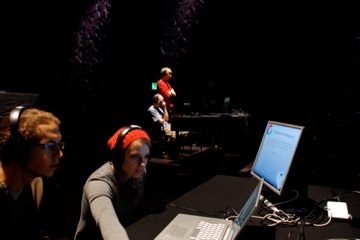QED data listening space
 |
The central installation was a virtual data listening space of quantum
electrodynamics (QED).
Data stemmed from a Monte-Carlo model of QED from the Institute of
Physics of the university
of Graz. Single configurations of the model could be chosen, that
statistically resembled very exactly
the mean value over many configurations at the temperature.
A person moved freely through space, his or her position and rotation captured by a motion tracking system. Each lattice point of the QED model had a fixed position in the tracking region. The clear localization of these points was reached with a binaural rendering - the person heard through headphones where the points were sounding and could move in between of them. The sonification coded energy and time development by pitch and rhythmic structures. A second tracking object held by the hand allowed to listen to energy contents of different space regions. |
|
In 4 additional stations we focused on different aspects of sonification and listening. In one station, a sonification of particle tracks of CERN were played. Data stemmed from simulations of the time projection chamber (TPC) of ALICE project of CERN. The tracks of electrons, positrons, pions and other particles could be compared to each other - either standing alone or in the context of the whole collision event they were detected. The sonification was largely based on the raw data of the TPC measurement. The measuring points were sonified individually depending on time and space position and their charge. Several perceptual cues were implemented in the sonification to make it easier for the listener to group the sounds of one track into one perceptual object. The pattern recognition which normally is programmed with a lot of effort, happens intuitively in the human brain. A documentation of the TPC-Sonification with listening examples can be found here. |
 |
 |
A further listening station was devoted to space filling curves
as means of reducing dimensions in sonification. A moore bee
moved virtually along a 3-dimensional Moore curve around the head of
a listener.
Binaural recordings were played to show the strength of this method, that opens a completely different space to the listener. Finally we showed simple methods, which can be used in sonifications to move circularly through a sound space. An example were Shepard tones, which seem to rise or descend eternally, but which return to the same sound after each period. |

 Previous:
xy-listening
Previous:
xy-listening

